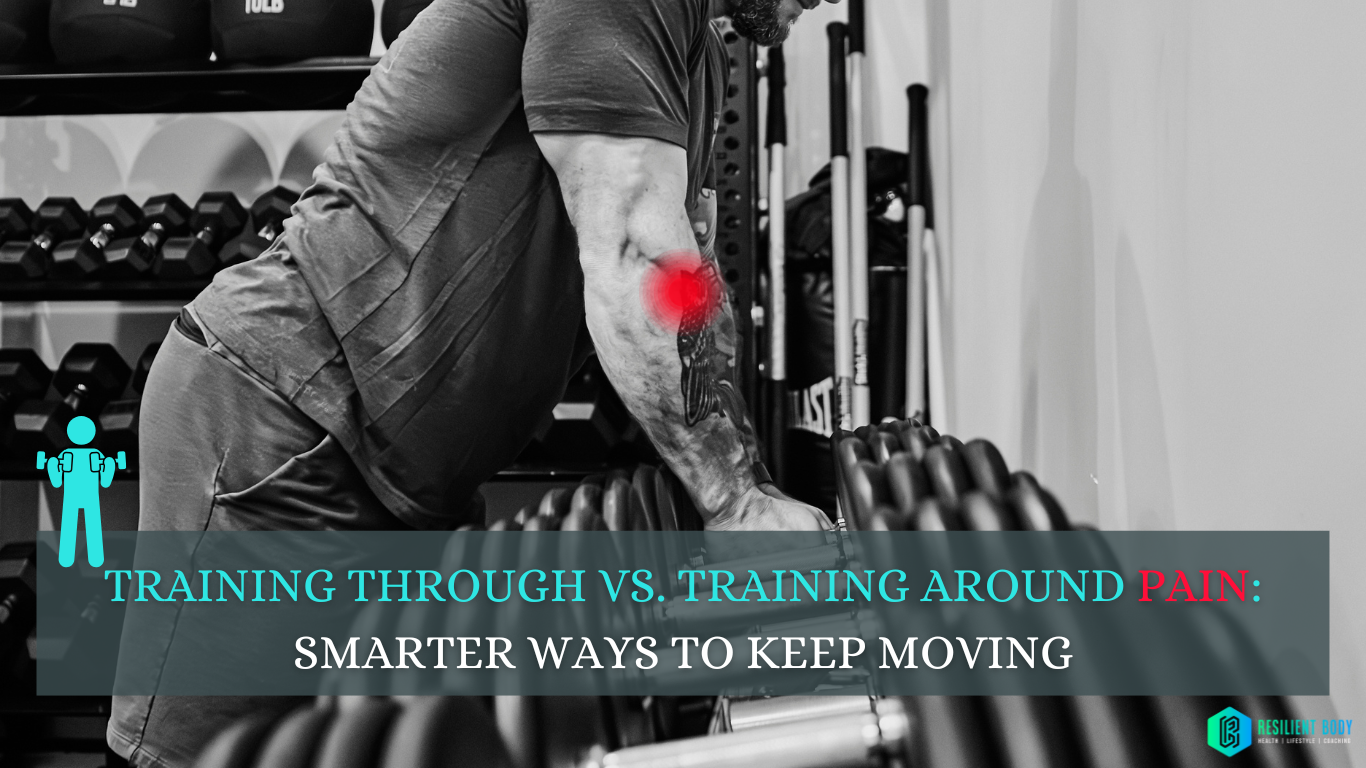Training Through vs. Training Around Pain: Smarter Ways to Keep Moving
Pain during training can be frustrating. Whether it’s your shoulder during pressing, your knee on a run, or your back after a heavy pull, the usual reaction is to stop everything. But here’s the truth: complete rest is rarely the solution.
At Resilient Body, we help people stay active through pain—not by ignoring it, but by using smart, science-backed strategies to keep you moving while symptoms calm down. The two main tools in our toolbox?
Training through and training around. We discussed this in another article recently but made a video to give some more concrete examples.
First, Let’s Talk About Shoulder Pain and Pain Generally (Because It Comes Up A Lot)
Most people assume shoulder pain means something is structurally “wrong”—a torn tendon, a labral tear, or arthritis that requires full rest or surgery.
But here’s what the science and our clinical experience actually show:
Pain ≠ damage. Many people have MRI findings (like rotator cuff tears or arthritis) and feel zero pain. Others have no imaging findings, yet still hurt.
The shoulder is adaptable. It’s one of the most mobile joints in the body, and with the right progressions, it can tolerate a surprising amount of activity.
Pain is complex. It’s influenced by load, sleep, stress, mindset, recovery—not just “tissue damage.”
Scans don’t tell the whole story. We prioritize how your symptoms behave with movement, not just what an image shows.
Rest is rarely helpful. Inactivity can prolong symptoms. Graded movement helps restore strength, confidence, and range of motion.
In short: You don’t need to fear your shoulder or pain. And you don’t need a perfect diagnosis to start getting better. Instead of focusing on clinical labels, we zoom in on some patterns:
What changed recently in your training?
How do your symptoms respond to different movements and other factors?
What variations feel good right now?
How can we adjust your program without losing progress?
That leads us into our two favorite frameworks for managing pain.
Training Through: Graded Exposure
Training through means we’re still using the movement pattern that causes discomfort—but with smart modifications to angle, load, or range. This approach is called graded exposure, and it’s a cornerstone in modern rehab.
Example:
If overhead pressing aggravates your shoulder, we might shift to a horizontal press like a floor or bench press. From there, we build back toward overhead by slowly increasing the pressing angle—maybe through incline variations—until you’re back to full range, pain-free.
This approach works because it:
Keeps the tissue active (which helps with healing)
Rebuilds confidence in the movement
Reduces sensitivity over time
It’s a progressive, personalized way to retrain the pattern, not avoid it.
Training Around: Smart Substitution
Now, if modifying the movement still doesn’t feel great, we use training around—choosing a similar exercise that works the same muscles without aggravating symptoms.
Example:
If overhead pressing still doesn’t feel right, a landmine press might be the perfect solution. It mimics the pressing pattern, but with a friendlier angle for the shoulder.
This strategy isn’t a cop-out—it’s smart programming. It keeps you progressing without pushing into pain.
Other examples:
Knee pain with running? Try incline running or walking, sled pushes, or cycling as a temporary substitute.
Back pain during deadlifts? We might shift to block pulls, trap bar variations, or hip thrusts.
Elbow pain with pulling? Neutral-grip rows, introducing straps or modified pull-downs can reduce specific strain while maintaining strength.
Why This Matters
The key is knowing when to train through, when to train around, and when to adjust more significantly. That’s where coaching makes all the difference.
We don’t treat pain with blanket rest or rigid diagnoses. Instead, we look at your story, your training history, and how your body responds in real time. Our goal is to modify, not stop—so you stay active, build resilience, and keep making progress even when setbacks pop up.
The Bottom Line
Pain doesn’t have to mean hitting pause on your training.
With the right approach, you can:
✅ Keep moving
✅ Respect your body’s current limits (keyword: current, not forever)
✅ Continue building strength and capacity
✅ Come out stronger on the other side
Sometimes that means training through the issue with smart progressions. Other times it means training around it with strategic substitutions. Either way, you don’t have to stop.
👉 Watch the demo video to see these principles in action with Coach Micah.
And if you’re working through something similar, we’re here to help. Let’s find a way to keep you moving forward.
Learn It Right in Small Group Training
Join a Class or Sign up For Personal Training!
Our small group classes and personal training sessions are some of the best ways to get hands-on coaching in a supportive, educational setting. Whether you’re working on movement patterns, strength, or just feeling better in your body, we’re here to guide you.
Announcements:
1:1 with Coach Nick. Nick is an incredibly skilled coach with a well informed and diverse background in performance and rehab to name only two of his strengths. He currently has availability for new 1:1 personal training clients. If you or anyone you know is looking to get started, we’d love to help!
New Small Group Fitness Class Times! New evening class times have kicked off at 5:30p M/W/F. Come get your fitness on in a fun and supportive small group environment.



